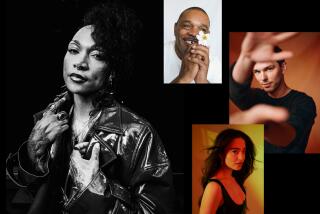In Your (Celebrity) Dreams
- Share via
If Gary Socol had a theme song, it would be, “To dream the impossible dream, To reach the unreachable star . . .”
You see, he collects dreams that simple folk have about celebrity folk. Wacky dreams, romantic ones, a few erotic ones.
It all began when Socol,--in real life a 38-year-old West Hollywood TV producer,--had his own dream: He was hanging out with Madonna at her digs, waiting for a white limo to whisk them who-knows-where. But an old white Plymouth pulled up with two men inside and, to his astonishment, the Material Girl jumped in. Madonna had been kidnaped.
“The whole world was looking for her,” he says. Then some nasty columnist smelled a publicity stunt and the entire world turned on her. Then Socol woke up.
Not long afterward, a friend, who was eight months pregnant, told him of dreaming that Jack Nicholson was making love to her in his swimming pool.
Socol wondered, “Are people across America having dreams about celebrities?” Was this a book crying to be written?
Several months ago, he began placing newspaper ads. A San Francisco journalist’s blurb about him was syndicated nationwide. Soon he was “getting dozens of letters every day.” To date, he estimates, at least 300. The most-dreamed-about celebs? Jerry Seinfeld and John Lennon.
Among Socol’s correspondents: A Cincinnati man who dreamed that his restaurant was overcrowded and understaffed on opening night. So who pitched in to bus tables? Richard Gere and Cindy Crawford. By the time this dreamer awakened, the dazzling duo had opted for full-time jobs as waiters.
A South Carolina woman dreamed of finding Delta Burke at her kitchen table, eating chicken legs and salami.
An older woman dreamed of being alone in an elegant ballroom, surrounded by Beautiful People. There was a tap on her arm and there was Fred Astaire, leading her onto the floor.
“You get the 59-year-old seamstresses who dream about Tom Cruise,” Socol says. Then, he says, there are the poignant dreams: A women who’d just lost a dear one said she felt at peace after being comforted by Michael Landon.
Many are improbable. A young architect dreamed of finding Anjelica Huston, in tatters, mopping floors on a college campus. She explained that she just loved doing floors and bathrooms. He kissed her--and she went back to her mopping.
Another dreamer was at a lavish party given by Joan Rivers. Rivers appeared poolside in a swimsuit, dived in and went into an Esther Williams routine. For her finale, she shot like a rocket 30 feet into the air, executing spiffy back flips on the return trip to the pool.
Some dreams are prophetic. A woman dreamed that she was shopping with Nancy Reagan. But Reagan rejected the dress the woman chose for her, saying it was a Size 1 and she wears a 5-6. Later, wide awake, the woman played 506 in a lottery game and won a tidy sum.
Socol’s personal favorite is from a Santa Monica man: In it, Barbra Streisand is possessed by demons that are making her sing hit after hit to a trio of priests in the last row of a theater. After each song, she removes one shoe and throws it at them. As she does, a new one grows on her foot. . . .
Socol won’t attempt to explain that one. He’s read widely on dream interpretation, but his book will be to entertain. He’s fascinated by “the influence celebrities have over our waking and sleeping lives.”
The working title? “Madonna Kidnapped (And Other Celebrity Dreams).” Dreamers can write to him at P.O. Box 461271, Los Angeles, Calif. 90046.
Socol thinks the book will be “very commercial.” And, as producer of E! Entertainment’s “Talk Soup”--which culls the week’s best moments from the talk shows--you can guess what else he’s thinking. . . .
A New Father Figure
So what do fathers really need? Not electronic gewgaws or cutesy boxer shorts.
What’s needed, suggests San Diegan Richard Louv in his new book, “FatherLove: What We Need, What We See, What We Must Create,” is a reconnection of fatherhood and manhood.
As the family crumbles, society finger-points: “First, it was teachers and schools; it must be their fault. Then single mothers; it must be their fault. Now, we’re moving on to fathers,” Louv writes.
But “what about the culpability of our companies and how they treat families; what about our neighborhoods, our urban planners, our political process?”
In his view, “The truth, however politically untidy, is that men will not move back into the family until our culture reconnects masculinity and fatherhood, until young men come to see fatherhood, not just paternity, as the fullest expression of manhood.”
He laments that too many dads, fearful of being seen as second-class employees on a Daddy Track and worn out by stress and long commutes, “have narrowed their universe to the workplace and the television.”
Gone are the simple pleasures of parenting, the meaningful moments--a day of fishing, a story at bedtime, the shared confidences.
Louv asks: “Why don’t we teach young boys that fatherhood makes you high?”
Policy-making, he adds, cannot be based on the assumption “that a fatherless society is inevitable,” he writes--even though one in four American children lives with a single parent, usually a female, often with little or no contact with the father. “We must make a national and cultural commitment to father-keeping.”
That means family-friendly workplaces, expanded roles for fathers as nurturers and involvement with other parents in the community.
Louv and his wife, Kathy, have two young sons. When the boys grow up, he hopes they will “have the courage to speak up and change policies for men and women in the workplace. I want them to be able to divorce their work; to know when to quit and come home and that there is comfort and life at home.”


